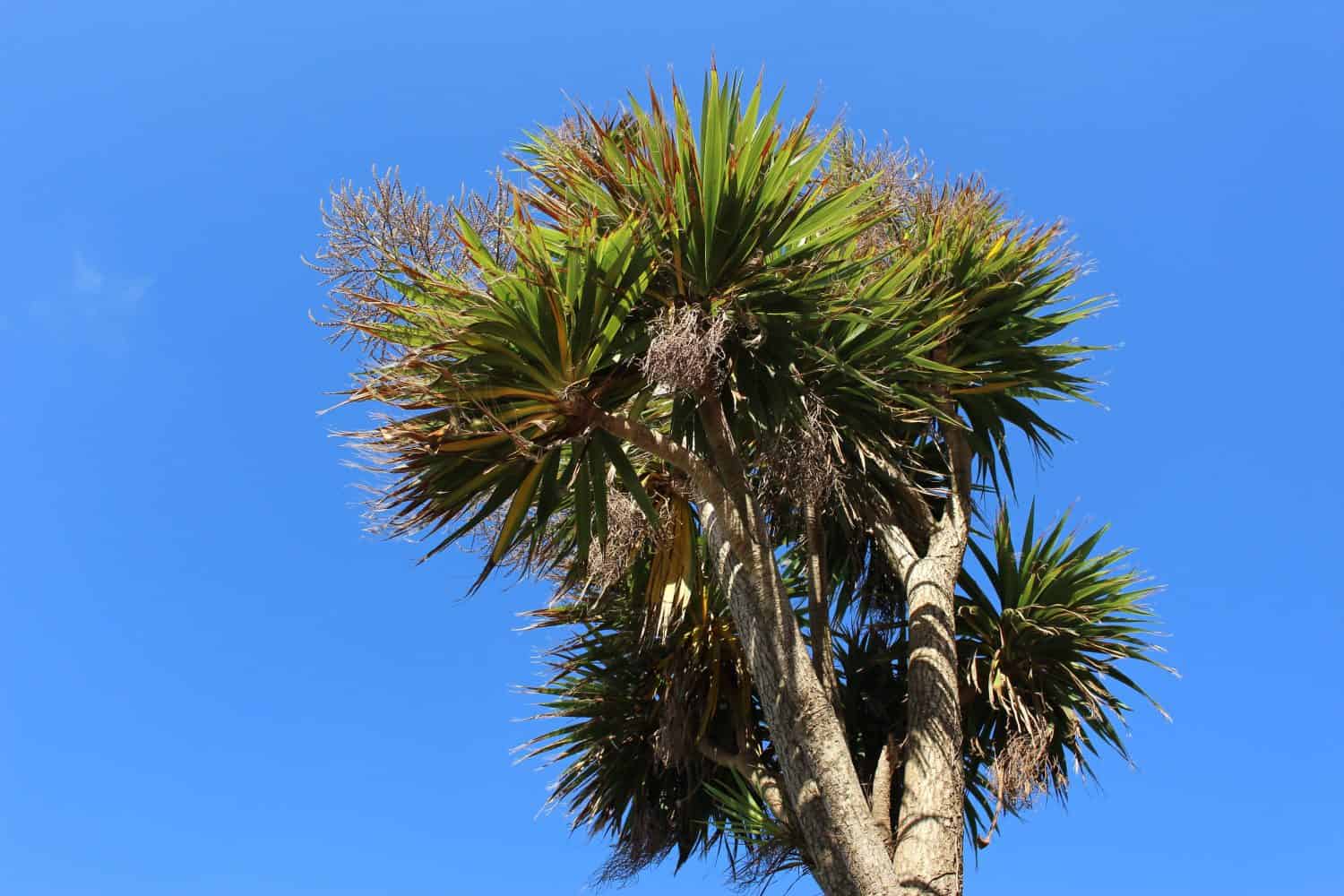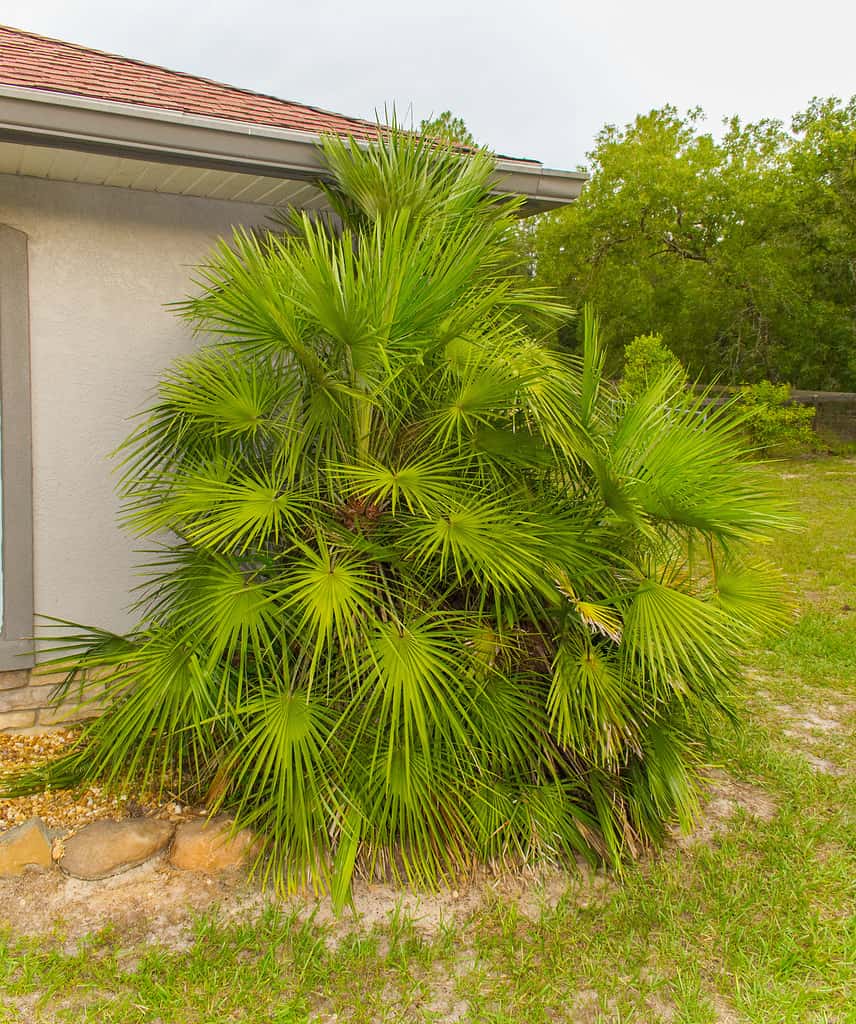When we think about Ireland, we often remember the beautiful features that beget the country’s nickname of Emerald Isle. One thing we don’t think about is palm trees. Palm trees are native to tropical and subtropical climates, far from what Ireland’s weather is like. So, it begs the question, palm trees in Ireland: can they really grow there?
“Palm Trees” in Ireland

Ireland has a tree that
lookslike a palm tree, but it really isn’t one.
©Aldercy Carling/Shutterstock.com
Many people believe they’ve seen palm trees all over Ireland, but that isn’t true. In fact, the tree that many people suspect to be a palm tree is actually the cabbage palm (Cordyline australis) or (Livistona australis), which is a branched monocot tree that was imported from New Zealand in 1823.
In Ireland, many residents refer to these as palms, but they aren’t actually a part of the palm tree family. Instead, they are a part of the monocotyledons clade of plants and are grass-like flowering plants. While the trees may appear to have a palm-like appearance, they aren’t a part of the palm family.
The cabbage palm can be seen all over Ireland as a decorative plant. Many residents use them to decorate their yards or community spaces. The reason that these trees are so popular is because they are what is called “cold-hardy” and can survive winter.
Cabbage palm species are hardy and can survive below 10 to 15 degrees Fahrenheit. Additionally, the species is wind-resistant and can survive in dry spells. Maintenance is also minimal, making them adaptable and a favorite of many.
However, there are real palm trees in Ireland. They are normally found in specific regions that can help the tree survive. Mainly, species of hardy palm trees are in the southern region of Ireland, which we will touch on later in the article.
Can Real Palm Trees Grow in Ireland?

Ireland’s climate isn’t the best place for palm trees to grow.
©eugenesergeev/iStock via Getty Images
Before concluding whether palm trees can grow in Ireland, we must understand the country’s climate. Ireland is known for its mild temperatures and oceanic climate. Average temperatures range depending on what region of the country you’re in. So, it can vary from the north to the south.
On average, the climate is influenced by the Atlantic Ocean and results in temperatures between 48 degrees and 50 degrees Fahrenheit. Northern Ireland’s climate is temperate and maritime and experiences high winds. It can range from 38 degrees Fahrenheit to 65 degrees Fahrenheit. On the flip side, Southern Ireland often has temperatures that range from 39 degrees Fahrenheit to 70 degrees Fahrenheit.
Now that we know the temperature, we can look at where palm trees thrive. Palm trees tend to thrive the best in tropical or subtropical regions with climates between 60 to 80 degrees Fahrenheit. Ireland is much different from that. While the country doesn’t see extreme highs or lows, the overall climate differs greatly from where palm trees thrive.
Palm trees grow the best when they have warm, sunny weather that doesn’t have extremes or wind. Mainly because the immature plants can’t survive the cold or wind. That said, Ireland doesn’t have extremes but cold weather with harsher conditions.
It’s possible that some species of palm trees can survive in Ireland’s southern regions. However, they will require a lot of upkeep to prevent them from dying. Below, we’ll take a look at the regions that these palm trees grow in and what species can thrive in the country.
What Types of Palm Trees Thrive in Ireland?
Believe it or not, there are a few species of palm trees that can survive Ireland’s climate. However, there are no native palm trees in Ireland. Let’s look at a few of the palm trees that have reportedly been spotted in Ireland.
European Fan Palm

Palms such as the European fan palm are hardy and can survive Ireland’s harsh winters.
©iStock.com/Chase D’animulls
The European fan palm (Chamaerops humilis) is one of two native palm trees in Europe. Countries the European Fan Palm is found in are Portugal, Spain, Italy, and even parts of Africa. It’s a slow-growing plant and can grow anywhere from eight to 15 feet tall and 6 to 10 feet wide. It’s one of the most hardy palms known to Europe and can survive in temperatures down to 10 degrees or more. Parts of the tree do get damaged, such as the leaves, but the trunk can survive winter.
Cretan Date Palm

There are no native palm trees in Ireland, but some species, such as the Cretan date palm, have been brought over from other parts of Europe.
©Kolinchev Andrii/Shutterstock.com
The Cretan date palm (Phoenix theophrasti) is the other native palm tree in Europe. It originates from Crete island, a part of southern Greece and Turkey. In terms of size, it can grow up to 49 feet tall and spans six to ten feet wide. Additionally, it is the hardiest date palm and can survive in cold weather in addition to high salt tolerance.
Chusan Palm

Some palm trees, such as the Chusan palm, have origins dating back to the early 1800s.
©Wut_Moppie/Shutterstock.com
The Chusan palm (Trachycarpus fortunei) originates from central and southern China and has been exported to other countries. It’s known as the windmill palm, Chinese windmill palm, or Chusan palm. The palm tree can grow up to 39 to 66 feet tall and has a trunk diameter of six to 12 inches. Out of arborescent palms, the Chusan palm has the best winter hardiness and can survive cold down to 10 degrees Fahrenheit.
Canary Date Palm

Out of all the palm trees in Ireland, the Canary date palm grows the tallest.
©ghostkaa/Shutterstock.com
The Canary date palm (Phoenix canariensis) originates from the Canary Islands and goes by Canary Island date palm and Pineapple palm. The tree can grow up to 40 to 60 feet tall. Unlike the other palms mentioned earlier, the Canary Date palm can’t withstand cold temperatures as much. The tree will suffer damage but can survive down to 20 degrees Fahrenheit.
What Region Do Palm Trees Grow in Ireland?
Ireland is often known for its harsh temperatures but does have a few regions where palm trees can flourish. Mainly, the southern regions of the country have milder temperatures that palm trees can adapt to. While the trees may take damage during the winter, their bases can survive and regrow the following season.
One region often “subtropical” in Ireland is the southwest area of Ireland. Places where palm trees can be seen are Dun Laoghaire Dalkey, Killiney, and the Iveragh Peninsula. These areas are best for palms due to the Gulf Stream on the West shores.
The wind helps keep the temperatures warm and consistent. In addition, there is hardly any frost when winter hits. This ensures that the palm trees are not destroyed and can reemerge next season.
The Bottom Line
Yes, Ireland does have palm trees despite its harsh winter climate. However, many confuse the cabbage palms as a palm tree due to the confusion of the term. While the cabbage palm is the dominant “palm tree,” Ireland does have real palm tree species alongside its coastal regions.
Particularly, the southwestern part of the country has perfect gulf weather that can help real palm trees survive. Many residents keep them in backyards and use the trees as an ornamental decoration outdoors. In the beachside areas, some palm trees can also be seen growing alongside the gulf.
That being said, it’s not common for palm trees to grow in Ireland, and most of the country doesn’t have them. All of the existing palm trees in Ireland are also brought over from different countries. Hopefully, this has helped you learn more about palm trees in Ireland and if they really grow there.
The photo featured at the top of this post is © Wut_Moppie/Shutterstock.com
Thank you for reading! Have some feedback for us? Contact the AZ Animals editorial team.







